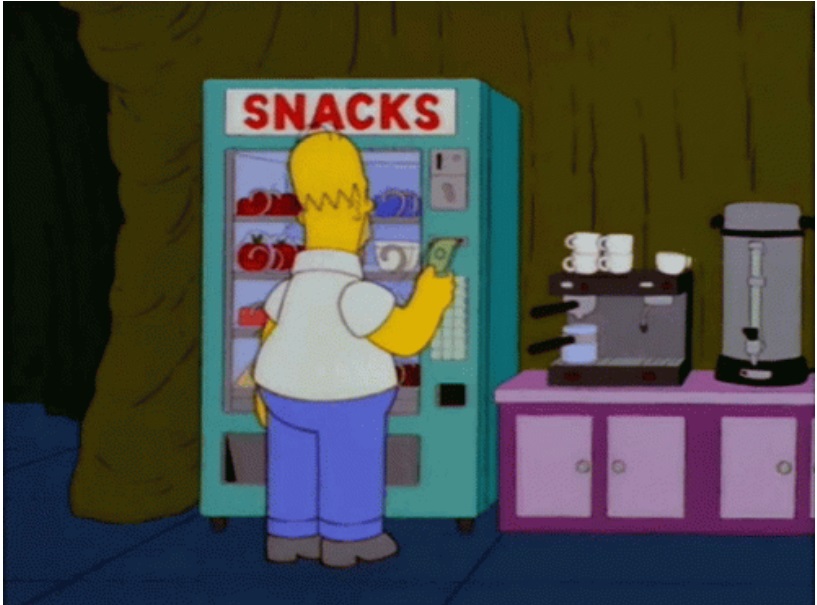
Vending machines have quietly earned a place in the fabric of American pop culture, appearing in countless films and TV shows as more than just props. In their simplicity, they’ve become symbolic, representing everything from convenience to isolation in the lives of the characters they surround. Whether tucked into the background of a bustling office or standing alone in a hospital corridor, vending machines seem to serve as silent witnesses to the drama, comedy, and tension that unfold around them.
From gritty crime dramas like Better Call Saul to the everyday mundanity of The Office, vending machines often function as subtle metaphors in storytelling. They are places of reflection, where characters contemplate choices, fuel their habits, or break up the monotony of life. Sometimes, they serve as humorous interruptions, like in The Office, where a character’s frustration with a stuck snack turns into a moment of levity. At other times, they reflect deeper societal themes like consumerism or loneliness, emphasizing the disconnect between human interactions in an increasingly automated world.
In American cinema, vending machines have taken on a deeper meaning over the years. Teen films from the 1980s, for example, often used vending machines as symbols of rebellion or decision-making. Today, they’ve become almost emblematic of an on-demand culture, where instant gratification is just a button press away. The sight of a vending machine in a scene often signals more than just a craving for a snack; it signals a moment of pause, a turning point, or even a subtle commentary on the characters’ lives.
In this article, we will explore some of the most memorable moments in American film and television where vending machines have made their mark, showing just how ingrained they have become in the storytelling of everyday life.
The Symbolism of Vending Machines in Film and TV
Vending machines are more than just convenient devices for dispensing snacks and drinks—they are rich with symbolism when used in film and television. In many cases, they represent the routine and predictability of everyday life, offering characters a moment of reflection or escape. Their presence in the background of scenes subtly signals the monotony of modern living, often appearing in offices, schools, hospitals, or even roadside gas stations. These locations themselves are often hubs of routine, and the vending machine becomes a physical manifestation of that routine.
Yet, vending machines also serve as symbols of choice. With just a few coins or a quick swipe, characters must decide between chips or candy, soda or water. This act of choosing is sometimes symbolic of deeper, more personal decisions that characters face. For example, in a scene where a character stands indecisively before a vending machine, it can signal a crossroads in their life—a metaphor for the weight of bigger, more impactful choices they must make. Films like The Breakfast Club use vending machines to emphasize moments of teenage rebellion, where a simple snack purchase can become a small act of defiance against authority.
At times, vending machines even represent isolation and loneliness. In shows like Breaking Bad or Mad Men, vending machines are often used as backdrops for characters who are experiencing personal turmoil. The solitary act of buying a snack in an empty hallway or late at night can mirror the emotional distance the character feels from those around them. They can also signify moments of contemplation or self-awareness, providing a pause in the narrative for the character to collect their thoughts.
The symbolic significance of vending machines, therefore, goes far beyond their practical use. Whether representing routine, choice, or isolation, they are a quiet yet powerful tool in the storytelling of American pop culture.
Famous Vending Machine Scenes in American Pop Culture
Over the years, vending machines have appeared in some of the most iconic moments in American film and television, where their presence adds depth to the scene, often in ways viewers may not initially recognize. These seemingly mundane machines have found their way into crucial moments of dialogue, character development, and even humor.
One of the most memorable examples comes from the critically acclaimed series Better Call Saul. The vending machine appears frequently in Saul’s (Jimmy McGill’s) world, often placed in scenes where he is waiting or contemplating his next move. The vending machine’s persistence throughout the series highlights Saul’s own persistence and determination as he grapples with his moral compass. One particular scene, where he struggles to get a candy bar from the machine, mirrors his struggles in life—small obstacles that represent larger issues. It’s a subtle yet effective way to convey his inner turmoil and the never-ending challenges he faces.
Another example is from the popular comedy series The Office. In this show, the vending machine becomes a comedic device, often involved in the humorous mishaps that occur in the Dunder Mifflin office. Whether it’s Kevin’s obsession with his favorite snacks or a frustrated employee trying to get an item that’s stuck, the vending machine adds to the absurdity of everyday office life. These scenes capture the trivial yet relatable moments in modern workplaces, making the vending machine a perfect symbol of the ordinary amidst the chaos.
The Simpsons, known for its sharp social commentary, often uses vending machines in a more exaggerated, humorous fashion. In several episodes, the machines themselves seem to have a mind of their own, malfunctioning in ways that frustrate the characters. In typical Simpsons style, the vending machine becomes a reflection of the quirks of modern consumerism—machines designed for convenience that sometimes deliver the exact opposite.
These famous scenes demonstrate how vending machines have transitioned from simple objects into recurring symbols in American pop culture, reinforcing their role not just as snack dispensers but as integral parts of storytelling.
Vending Machines in American Cinema: A Subtle Reflection of Society
American cinema has long been a mirror reflecting societal trends, attitudes, and transformations. Within this vast landscape, vending machines, though seemingly insignificant, have served as a subtle yet telling reflection of societal shifts. As symbols of convenience, choice, and even alienation, they quietly embody the consumer-driven culture that has shaped modern America. Their presence in film is not coincidental but a deliberate tool used by filmmakers to comment on the human experience in a consumerist world.
In the teen films of the 1980s, for example, vending machines became symbols of youthful independence and rebellion. In iconic movies like The Breakfast Club, they weren’t just used as snack dispensers; they were tools of defiance. Teenagers, trapped in detention and navigating the pressures of high school hierarchy, used vending machines to assert a small sense of control over their environment. Here, vending machines symbolized choice—what to eat, when to eat—and the freedom to make decisions without adult oversight. In a broader sense, they reflected the rise of youth culture during this era, where convenience and on-demand access to products began to permeate daily life.
In more recent films, vending machines continue to appear, often as silent observers of a rapidly changing society. In the digital age, these machines have evolved, much like the society they inhabit. Films like Her and Blade Runner 2049 depict futures where technology and human interaction intersect in complex ways, and vending machines serve as metaphors for this intersection. In Her, for instance, the vending machine is a part of the seamless integration of technology into everyday life—a constant, reliable companion offering sustenance in a world where human relationships are increasingly mediated by digital interfaces.
But perhaps the most poignant reflection of society through vending machines comes in films that explore themes of isolation and alienation. Characters who interact with vending machines in lonely, dimly lit settings are often depicted as emotionally distant or disconnected. In movies like Lost in Translation or Up in the Air, vending machines are used to emphasize the loneliness of the protagonists. They offer a brief respite, a moment of familiarity in otherwise unfamiliar surroundings. The act of purchasing something from a vending machine—a transaction devoid of human interaction—becomes a metaphor for the characters’ inability to connect with others.
Ultimately, vending machines in American cinema are more than props; they are reflections of the cultural values, challenges, and complexities of the time. From symbols of rebellion to metaphors for isolation, they capture the shifting landscape of consumerism and human interaction, making them a powerful yet understated narrative tool.
The Evolution of Vending Machines as Cultural Icons
Vending machines have come a long way from their origins as simple dispensers of candy and soda. Today, they stand as cultural icons, emblematic of modern convenience and the ever-evolving nature of consumerism. Over time, they have moved from the periphery of society to the forefront of public consciousness, particularly as they appear in more advanced, high-tech iterations. Their evolution parallels shifts in American culture, especially regarding the increasing value placed on convenience, immediacy, and variety.
The vending machine’s rise as a cultural icon began in the mid-20th century when the machines became a ubiquitous fixture in schools, offices, and public spaces. They offered people something novel at the time—instant gratification. There was no need to wait in line or interact with a cashier; you simply inserted coins and received your snack of choice. This simple transaction mirrored the growing consumer culture in post-war America, where the focus was on speed, efficiency, and satisfaction. Vending machines came to symbolize the future of commerce, a step toward a society where desires could be fulfilled with minimal effort.
As vending machines evolved, so did their cultural significance. The introduction of healthier options in the late 1990s and 2000s reflected a societal shift toward wellness and balanced living. No longer just a purveyor of sugary treats and salty snacks, vending machines began to offer everything from organic granola bars to protein shakes. This evolution mirrored the growing health-consciousness in American society, where convenience no longer had to mean unhealthy choices. The vending machine became a symbol of a more informed, health-savvy consumer base that demanded better options.
Today, vending machines have entered the digital age. With touchscreen interfaces, cashless payments, and even the ability to customize orders, they embody
the modern consumer’s expectation of personalized, tech-driven experiences. In this sense, vending machines reflect the broader societal shift toward technology-enabled convenience. This evolution has also made them more than just snack dispensers—they are now vehicles for innovative business models. In Japan, vending machines sell everything from hot meals to electronics, and the trend is starting to catch on in America as well.
Vending machines have become cultural icons not just because of what they offer, but because of what they represent—a snapshot of society’s changing priorities. From symbols of youthful rebellion in the 1980s to today’s embodiment of tech-enabled convenience, vending machines have transcended their original purpose. They are now woven into the cultural fabric, illustrating society’s ongoing pursuit of ease, choice, and instant gratification.
Why Vending Machines Remain Relevant in the Digital Age
In an era where online shopping, food delivery apps, and subscription services dominate the consumer landscape, one might think vending machines are a relic of the past. However, these machines have proven to be remarkably resilient, adapting to the digital age and remaining a relevant part of modern commerce. Their continued presence in offices, schools, gyms, and public spaces speaks to their enduring appeal. Vending machines have not only survived but thrived, evolving alongside the very technology that could have rendered them obsolete.
One reason vending machines remain relevant is their ability to adapt to changing consumer needs. The integration of technology, such as cashless payments and touchscreen displays, has breathed new life into the industry. With the simple swipe of a card or tap of a phone, consumers can access their favorite snacks and beverages without the hassle of carrying cash. This seamless transaction mirrors the convenience offered by online shopping, but with the added benefit of immediate access. In this way, vending machines cater to the modern consumer’s desire for speed and ease, keeping them competitive in the digital marketplace.
Additionally, vending machines offer a unique advantage over online services: they are location-based and instant. While apps like Uber Eats and Amazon can deliver products, they still involve wait times and often come with delivery fees. Vending machines, on the other hand, provide immediate gratification. Whether someone needs a quick snack during a work break or a refreshing drink after a workout, vending machines are strategically placed to offer what is needed at the exact moment it’s desired. This ability to satisfy “in-the-moment” cravings gives vending machines an edge that even the most efficient delivery services cannot match.
Moreover, vending machines have become more versatile in what they offer. From healthier food options to specialty beverages and even non-food items like electronics and personal care products, modern vending machines cater to a wider array of needs than ever before. This adaptability has allowed them to stay relevant in an age where consumer preferences are rapidly shifting. Businesses and locations that install vending machines appreciate their low-maintenance, high-reward model, particularly with services that handle restocking and maintenance, making vending machines an attractive option for busy environments.
In a world that prizes convenience, vending machines are evolving to meet new consumer expectations while maintaining their core strength: instant access. They are a testament to how traditional systems can innovate to stay relevant in a tech-driven era. Their ability to blend technology with instant service ensures that they will remain a fixture of modern life, no matter how digital the world becomes.
The Enduring Appeal of Vending Machines in Popular Culture and Society
From their symbolic presence in American film and television to their evolution as a cultural icon and their resilience in the face of digital disruption, vending machines have proven themselves to be more than just snack dispensers. They are ingrained in the fabric of modern society, serving as symbols of convenience, choice, and reflection. As this article has shown, their role in popular culture is as much about what they represent as it is about what they provide.
Vending machines have become part of the backdrop of American life, appearing in key scenes in movies and television shows, often reflecting the emotional states of characters or the cultural environment in which they exist. Whether in a tense moment of indecision, a comedic exchange, or a lonely pause, the presence of a vending machine subtly reinforces the themes of routine, convenience, and isolation that so often define modern life.
Their evolution into cultural icons mirrors the larger societal trends at play—health-conscious consumers demanding better options, the growing expectation of personalized experiences, and the ever-increasing reliance on technology to streamline everyday tasks. Yet, despite these changes, vending machines have maintained their core appeal: instant gratification, wherever you are. In many ways, they are the ultimate expression of consumer convenience, offering products on demand without any human interaction.
Even in today’s digital age, where nearly every transaction can be completed online, vending machines remain relevant because of their adaptability and their ability to fulfill immediate needs. Their seamless integration of technology, combined with their strategic placement in high-traffic areas, ensures that they will continue to be a fixture of modern life, both in the physical world and in the cultural imagination.
In conclusion, the vending machine’s journey from simple snack dispenser to pop culture icon reflects its adaptability and enduring relevance. As society continues to evolve, one thing remains certain: vending machines will continue to offer a unique blend of convenience and cultural significance, securing their place as both a practical tool and a subtle symbol of modern life.


